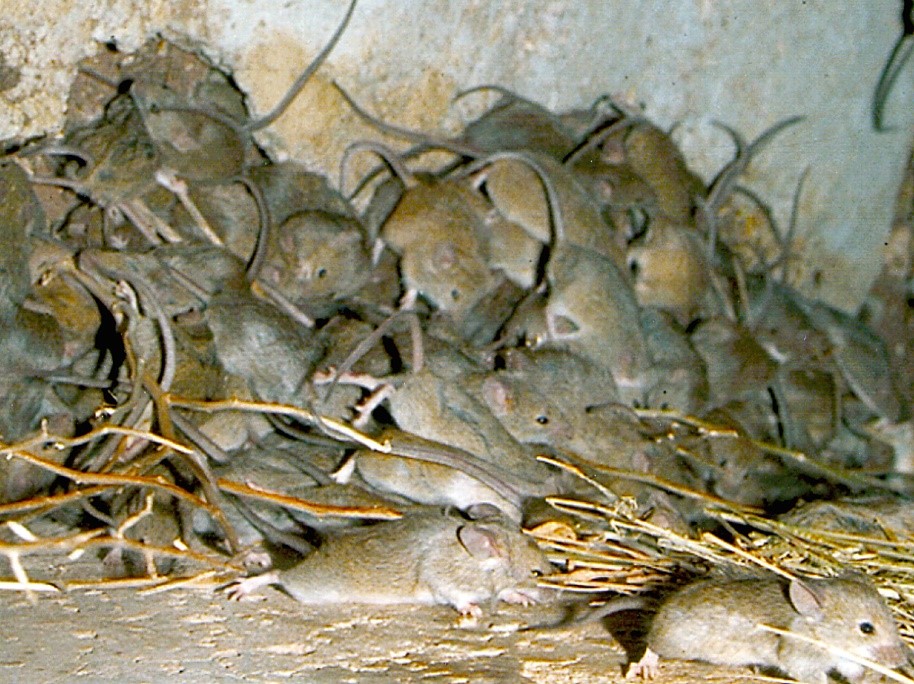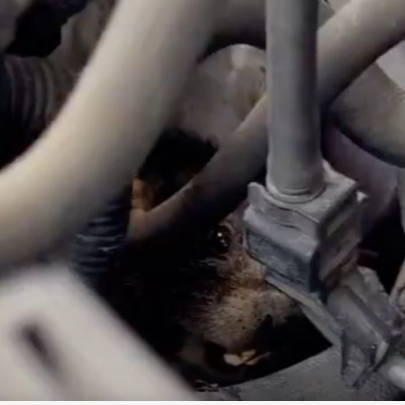Mice plagues have occurred in Australia many times in the past ever since mice were first introduced in the continent by European merchants and travellers.
The ample amount of farms and farmlands there make it very attractive for the mice to find food and shelter there. The recent rains and a bumper harvest have led to a full-blown plague in the rural parts of New South Wales and Queensland which is making daily life miserable for the citizens. Many reports have quoted this to be the worst mice infestation in decades in Australia.

These mice live in the farms during the day and come out at night in thousands to completely lay the lands to waste. They eat everything that is available and many farmers have reported the loss of their harvest because of these mice.
Grocery store owners, farmers, hotel managers and members of the community are facing the adversity of this plague that has gotten way out of hand. The rural parts of northern, western and southern Australia are being completely ravished by these mice that come in great numbers.
Supermarkets and restaurants that have food stocked are experiencing a hard time as well. Pesky little mice have managed to get into every cupboard and larder. Grains, fruits and even the containers that food comes packaged in are all destroyed by the mice. Cars and other vehicles are at the mercy of these rodents too. They cling inside through the bonnets and chew on all the wirings and other parts made up of polymeric materials.
Homes and barns, hospitals and other public places are also facing adverse situations dealing with these mice. The mice reproduce way too fast and any method to curb them has proven to be unsuccessful so far. All the baits and traps have been rendered useless because of the rapid rise in their numbers.
The exponential rise in mice numbers has led to many mouse-related diseases occurring. They carry many germs with them that they spread everywhere they visit and cause diseases. Mice urine and droppings contain bacteria and other pathogens that can cause various ailments in us humans.

Many accounts of the ongoing plague has been reported and written. Some of them are given below:
“An ‘absolute plague’ of mice is ravaging eastern Australia”
“Mice in the cabinets. Mice in the streets. Thousands upon thousands of mice in the barn, pooing so much it takes six hours to clean up their waste.
These are scenes from Queensland and New South Wales, Australia, where an out-of-control mouse infestation is making life miserable for farmers, grocers and other citizens of the eastern Australian states.
Some farmers have already lost entire grain harvests to the rampaging mice, according to local media reports, while hotels have had to close because they can’t keep the critters out of the rooms. Staff at a grocery store in a small town northwest of Sydney reported catching as many as 600 mice a night. So far, at least three people have visited the hospital with rodent bites, The Guardian reported.
Steve Henry, a researcher at CSIRO (Australia’s national science agency) told The Guardian that the infestation is likely the result of an unusually large grain harvest, which drew more hungry mice to the area’s farms earlier in the season than usual.
“They start breeding earlier and because there’s lots of food and shelter in the system, they continue to breed from early spring right through into the autumn,” Henry said.
Despite these efforts, Alan Brown, a farmer from the New South Wales city of Wagga Wagga, said that the plague was likely just beginning, considering the rapid pace of breeding in mice; a single breeding pair can produce a new litter every 20 days or so, birthing more than 500 offspring in a season, according to Reuters.
“A mature female can breed every three weeks, they can pump them out,” Brown said. “And that’s what is going on … it is building up to a massive plague.”
In addition to being a nuisance and business threat, mouse plagues can also be vectors of disease, according to the Queensland Government’s 1998 report on mice in Queensland.”
“Australian Town Hit By Worst Mice Plague ‘in Decades’; Rodents Bite People, Invade Homes”
“Rodents ran haywire in farms in Gilgandra, northwest of Sydney, Australia, destroying harvest, entering hospitals biting patients and electrical wires.
In a statement to Australian Broadcasting Company (ABC), a farmer by the name of Ron Mckay said that at night thousands and thousands of mice covered the floor, moving around rapidly. Local reports cited at least 3 mice-related injuries among the patients at healthcare centers in Tottenham, Walgett and Gulargambone. Mice were found sailing inside water tanks, trapped in sealed food containers, pantries and wardrobes of homes, fouling the previously clean spaces with faeces and stinky smells as the mice plague, worst in decades, spread in NSW.
A farmer in Wagga Wagga and a member of the NSW Farmers Association told The Guardian that mice infestation has incurred him $300,000 (£168,000) loss as the rodents destroyed crops. The only way out is hoping that heavy downpours drown the rodents in their bills, locals told reporters. The mice swarm destroyed acres of hay bales, and not sparing the grocer’s communities, the rodents invaded shops in Coonamble, north-west of Sydney.
A local grocer in Gulargambone told Sky News that the staff was catching nearly 500 mice or sometimes 600 at night. “It’s pretty gross,” he said. He added that the shops stink and many mice die inside the supermarkets the locals relied on for foodstuff. People are “freaked out” and are going elsewhere for groceries, he said. The NSW government’s Department of Primary Industries found that the on-farm rodent control programs that rely on rodenticides alone to control and manage rodent problems aren’t effective or sustainable.”
C Tech Corporation’s 100% eco-friendly product Rodrepel™ can prove to be a real game-changer in the situation. It works on the principle of repellence and does not kill the rodent.
Rodrepel™ triggers a fear response in rodents. It causes severe temporary distress to the mucous membrane of the rodents due to which the pest stays away from the application. The product triggers an unpleasant reaction in case the pest tries to gnaw away at the application. After encountering the above-mentioned emotions, the animal instinctively perceives it as something it should stay away from and stores this information for future reference. The fact that certain rodents are repelled is mimicked by other rodents as well. Thus, the other rodents too stay away from the applications. The unpleasant experience is imprinted within the animal’s memory and passed on to its progeny.
It will cause the rats to develop an aversion to all applications treated with the product. This will lead to the rodents naturally staying away from it. And because of conditioning and association, the progeny will also stay from them, thus giving a long term solution to the problem at hand. If the proper application is carried out, the rodents will find themselves with no readily available food. If this continues for a considerable time, the rats will start to move in search of food, thus vacating the area.
The products are available in the form of a solid masterbatch, liquid concentrate, lacquer, wood polish additive and spray.
The masterbatch can be incorporated into a range of polymeric and coating applications including films, wires and cables, pipes, etc. thereby making the end application rodent resistant. If silage films that are used for wrapping bales, hay and other farm harvest is incorporated with the masterbatch, then all these applications and other farm produce can be protected from rat attacks.
The liquid concentrate can be diluted with paints and other organic solvents and can be applied on walls of the infested area, like the interior and exterior of the houses, barns, grocery store buildings, hospitals, offices, etc. The liquid concentrate can also be diluted with water and used as a spray to spray around the infested area.
The already installed cables, pipes, and other applications can be coated with the lacquer to protect them from the rodents gnawing on this application and thus preventing the damage. The lacquer is a transparent product and it does not wear off easily.
The wood polish additive can be blended with wood polish and applied on the wooden articles and furniture used in hospitals and around houses. The fences around farms and farmlands can also be coated with wood polish mixed with the anti-rodent additive, making them more effective barriers and helping to stop the influx of more rats into the farms.
Our newly developed product is in the form of a spray and is an easy-to-use product. It can be sprayed around the pest entry point areas to repel the rodents and prevent them from entering the premises.
Rodrepel™ is cost-effective, eco-friendly and safe for everybody including us humans and the environment as a whole. It is RoHS, RoHS2, RoHS3, REACH, NEA, EU BPR, APVMA compliant and FIFRA exempted.
Contact us at technical.marketing@ctechcorporation.com if you’re facing problems with rodents and get the best remedies to combat the pest menace.
Also, visit our websites:
1] http://www.ctechcorporation.com/
Follow our Facebook pages at:
1] https://www.facebook.com/Combirepel-411710912249274/
2] https://www.facebook.com/Termirepel-104225413091251/
3] https://www.facebook.com/Rodrepel-120734974768048/
Follow us on our Twitter pages at:
1] https://twitter.com/rodrepel


